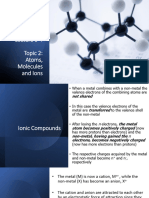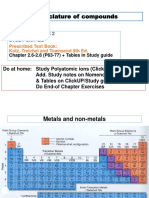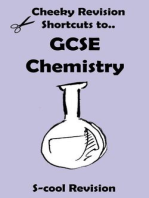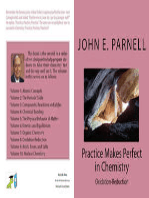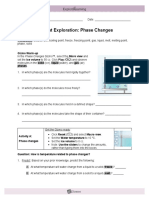Compound Naming Study Guide
Uploaded by
Justin SnyderCompound Naming Study Guide
Uploaded by
Justin SnyderChemistry: Second Semester; Test 2 Polyatomic Ions Acetate: C2H3O2 Oxalate: C2O42 Permanganate: MnO4 Phosphate: PO43
Carbonate: CO32 Chlorate: ClO3
Hydrogen Carbonate: HCO3
Dichromate: Cr2O72
Sulfate: SO42 Nitrate: NO3
Chromate: CrO42
Hydroxide: OH
Hydride: H Ammonium: NH4+
Cyanide: CN
Polyatomic Ion Nomenclature -ate endings (9 of them) all end with oxygen Original Polyatomic Ion Remove 1 Oxygen: ____-ite Remove 2 Oxygen: hypo-___-ite Add 1 Oxygen: per-____-ate Doesnt conduct electricity CuCl(s) Water added Cu+ (aq)+ Cl (aq) Doesnt conduct electricity Conducts electricity
ClO3: Chlorate ClO2: Chlorite ClO: Hypochlorite ClO4: Perchlorate
Copper and Chlorine are bonded because of their positive and negative charges. They want to neutralize. When CuCl(s) and water are combined, they separate, allowing the Cu (a metal) to conduct electricity. Metals have positive charges (give away electrons); non-metals have negative charges (receive electrons) Place metals first in a formula
Ions: atoms or groups of atoms with a charge Cations: ions with positive charge; lose electrons
Anions: ions with negative charge; gain electrons Ionic Compounds: composed of cations and anions held together by electric attraction that combine so that the overall charges are neutral/equal. Ionic compounds have very strong bonds. They are metals bonded to non-metals. Physical Properties of Ionic Compounds: tend to be solid at room temperature; high melting/boiling points; melt is able to conduct electricity; conduct electricity in aqueous solution; solid form doesnt conduct electricity; solid is brittle; basic unit is called formula unit
C12H22O11 water added C12H22O11
Doesnt conduct electricity *didnt form ions, just broke into individual molecule when water was added Molecular compounds: composed of discrete neutral molecules held together by relatively weak forces. Non-metals bonded to non-metals. Basic unit is the molecule. Physical properties of molecular compounds: tend to be liquid or gas at room temperature; low melting/boiling point; when solids melt, they break into neutral molecules (dont conduct electricity); solids dont conduct electricity; aqueous solutions dont conduct electricity. Atomic Compounds: form of crystalline solid in which atoms of an element are bonded to atoms of the same element (pure metals, diamonds, etc.) *Note: Why water separates IONIC compounds: One side is more negative; one side is more positive = polar
Nomenclature of Ions Monoatomic ions: ions formed from a single atom Metals form cations: naming element name + gold ion (i.e. gold ion) Non-metals tend to form anions: naming element base + ide + ion (i.e. Ion oxide)
Compounds have neutral charges due to evenly bonded cations and anions: Naming cation first (see below)
Binary Ionic Compounds: composed only 2 different elements; metal non-metal; neutral charge naming: name of metal + Roman numeral (if more than 1 charge indicating charge) + nonmetal + ide Examples of naming
Mg2+; Br1- MgBr2 Magnesium Bromide Cu+; Cl- CuCl Copper (I) Chloride Cu2+; Cl- CuCl2 Copper (II) Chloride
Polyatomic Ionic Compounds: 3 or more different elements; neutral charge Example: Ca
2+
; (Co3)2- CaCo3 Calcium Carbonate
Binary Molecular Compounds: composed of 2 different elements; nonmetal-nonmetal; ide; prefixes Examples: CO: Carbon Monoxide CO2: Carbon Dioxide C2O: Dicarbon Monoxide Naming: 1st element (prefix if more than 1) + 2nd element (always prefix) + ide Prefixes: 1: mono 2: di 3: tri 4: tetra 5: penta 6: hexa 7: hepta 8: octa 9: nona 10: deca
Acid Nomenclature Ate ic Ite ous icateiteous: use to remember When there are only two elements (3rd example), add hydro before the 2nd element base, and use ic as the ending.
H+ and SO4 H2SO4(aq) Sulfuric Acid (ate ic) H+ and NO2 NHO2(aq) Nitrous Acid (ite ous) H+ and Cl- HCl (aq) Hydrochloric Acid
Periodic Table Notes Hydrogen: in a world of its own; 1 charge metal families Group 1: Alkali metal; 1 charge Group 2: Alkaline metal; 2+ charge Groups 3-12: Transition metals; charge varies Some groups 13-15: other metals; charge varies Properties: shiny luster, malleable, ductile (wire), high conductivity (heat and electricity), soupy electrons, solid at room temperature (except mercury)
Group 18: Noble gases; do not form ions nonmetal Group 17: Halogens; 1- charge families Some groups 16-14: other nonmetals Properties: dull luster, solids tend to be brittle, many are gases at room temperature, low conductivity (heat and electricity)
Groups 13-16: Metalloids Properties: semi-conductors, solid at room temperature, dull/shiny, malleable/brittle
Structure Notes
no atoms bonded (Ar gas)
= 1 element # of types of atoms > 1 compound all atoms bonded (chunk Cu) small bonded groups (O2) small bonded groups (H2O) all atoms are bonded (NaCl)
atom
atom molecule molecule formula unit molecular ionic atomic
You might also like
- The Water Puzzle and The Hexagonal Key by Mu Shik John100% (1)The Water Puzzle and The Hexagonal Key by Mu Shik John73 pages
- VIDEO GUIDE FOR BOZEMAN BIOLOGY Water As A Polar MoleculeNo ratings yetVIDEO GUIDE FOR BOZEMAN BIOLOGY Water As A Polar Molecule1 page
- Chemical Nomenclature: Charge Formul Name Formul Name A ANo ratings yetChemical Nomenclature: Charge Formul Name Formul Name A A4 pages
- Chap 9 Chemical Names and Formulas PPT Glembocki 2016100% (1)Chap 9 Chemical Names and Formulas PPT Glembocki 2016115 pages
- Supplemental Notes in Gen Chem 1 First QuarterNo ratings yetSupplemental Notes in Gen Chem 1 First Quarter6 pages
- Lecture 2 - Molecules, Ions and Compounds (1) - 1No ratings yetLecture 2 - Molecules, Ions and Compounds (1) - 132 pages
- Atoms, Compounds, Mixtures, Molecules and ElementsNo ratings yetAtoms, Compounds, Mixtures, Molecules and Elements91 pages
- Writing Chemical Formula and Naming CompoundsNo ratings yetWriting Chemical Formula and Naming Compounds16 pages
- Chemical Nomenclature - Chemistry For MajorsNo ratings yetChemical Nomenclature - Chemistry For Majors20 pages
- CHE1244 Introduction to Inorganic Chemistry-24-2-2025 (FINAL)No ratings yetCHE1244 Introduction to Inorganic Chemistry-24-2-2025 (FINAL)163 pages
- The Modern View of Atomic Structure: An Introduction 2.5-2.8No ratings yetThe Modern View of Atomic Structure: An Introduction 2.5-2.83 pages
- Comparison of Properties of Ionic and Covalent CompoundsNo ratings yetComparison of Properties of Ionic and Covalent Compounds77 pages
- CHM131 - CHAPTER 2 - Elements, Compound, Chem Eq & Cal - PrintNo ratings yetCHM131 - CHAPTER 2 - Elements, Compound, Chem Eq & Cal - Print54 pages
- Engineering Chemistry ENC115C/SEH115B Chemical Substances Mr. R. BerkersNo ratings yetEngineering Chemistry ENC115C/SEH115B Chemical Substances Mr. R. Berkers16 pages
- CHM 171 Study Unit 2.2 Nomenclature of Compounds100% (1)CHM 171 Study Unit 2.2 Nomenclature of Compounds40 pages
- Ch. 5 Notes: Types of Compounds: A. Chemical FormulaNo ratings yetCh. 5 Notes: Types of Compounds: A. Chemical Formula5 pages
- Lesson 1.2 Writing and Naming of Compounds-Group Upload100% (1)Lesson 1.2 Writing and Naming of Compounds-Group Upload60 pages
- Activity No 2 - Exercises On Nomenclature (E8-19)No ratings yetActivity No 2 - Exercises On Nomenclature (E8-19)6 pages
- Chemical Elements Pocket Guide: Detailed Summary of the Periodic TableFrom EverandChemical Elements Pocket Guide: Detailed Summary of the Periodic TableNo ratings yet
- Practice Makes Perfect in Chemistry: Oxidation-Reduction with AnswersFrom EverandPractice Makes Perfect in Chemistry: Oxidation-Reduction with AnswersNo ratings yet
- University of Basra For Oil and Gas: 1-Chapter One100% (1)University of Basra For Oil and Gas: 1-Chapter One11 pages
- Course Outline - Lecture Course Outline LectureNo ratings yetCourse Outline - Lecture Course Outline Lecture71 pages
- Surface TensionpdfFilename: Surface Tensionpdf PDFNo ratings yetSurface TensionpdfFilename: Surface Tensionpdf PDF18 pages
- SA 15 16 XII XII Chemistry Unit-3 Section-ANo ratings yetSA 15 16 XII XII Chemistry Unit-3 Section-A17 pages
- 4th Grading - Grade 7 Environmental ScienceNo ratings yet4th Grading - Grade 7 Environmental Science5 pages
- The Water Puzzle and The Hexagonal Key by Mu Shik JohnThe Water Puzzle and The Hexagonal Key by Mu Shik John
- Chemistry: a QuickStudy Laminated Reference GuideFrom EverandChemistry: a QuickStudy Laminated Reference Guide
- VIDEO GUIDE FOR BOZEMAN BIOLOGY Water As A Polar MoleculeVIDEO GUIDE FOR BOZEMAN BIOLOGY Water As A Polar Molecule
- Chemical Nomenclature: Charge Formul Name Formul Name A AChemical Nomenclature: Charge Formul Name Formul Name A A
- Chap 9 Chemical Names and Formulas PPT Glembocki 2016Chap 9 Chemical Names and Formulas PPT Glembocki 2016
- Atoms, Compounds, Mixtures, Molecules and ElementsAtoms, Compounds, Mixtures, Molecules and Elements
- CHE1244 Introduction to Inorganic Chemistry-24-2-2025 (FINAL)CHE1244 Introduction to Inorganic Chemistry-24-2-2025 (FINAL)
- The Modern View of Atomic Structure: An Introduction 2.5-2.8The Modern View of Atomic Structure: An Introduction 2.5-2.8
- Comparison of Properties of Ionic and Covalent CompoundsComparison of Properties of Ionic and Covalent Compounds
- CHM131 - CHAPTER 2 - Elements, Compound, Chem Eq & Cal - PrintCHM131 - CHAPTER 2 - Elements, Compound, Chem Eq & Cal - Print
- Engineering Chemistry ENC115C/SEH115B Chemical Substances Mr. R. BerkersEngineering Chemistry ENC115C/SEH115B Chemical Substances Mr. R. Berkers
- Ch. 5 Notes: Types of Compounds: A. Chemical FormulaCh. 5 Notes: Types of Compounds: A. Chemical Formula
- Lesson 1.2 Writing and Naming of Compounds-Group UploadLesson 1.2 Writing and Naming of Compounds-Group Upload
- GCSE Chemistry Revision: Cheeky Revision ShortcutsFrom EverandGCSE Chemistry Revision: Cheeky Revision Shortcuts
- Chemical Elements Pocket Guide: Detailed Summary of the Periodic TableFrom EverandChemical Elements Pocket Guide: Detailed Summary of the Periodic Table
- Practice Makes Perfect in Chemistry: Oxidation-Reduction with AnswersFrom EverandPractice Makes Perfect in Chemistry: Oxidation-Reduction with Answers
- University of Basra For Oil and Gas: 1-Chapter OneUniversity of Basra For Oil and Gas: 1-Chapter One
- Surface TensionpdfFilename: Surface Tensionpdf PDFSurface TensionpdfFilename: Surface Tensionpdf PDF






















